There never seems to be enough blue animals in nature, so as bees are a passion of ours, so we want to tell you all about the blue carpenter bee. Their habitat, feeding habits, behavior, life cycle and other aspects of the Blue Carpenter Bee.
People usually observe large bees of different types and colors lingering around your doors, flowerpots, gardens, and backyards. More often than not any bees you see in woodwork are Carpenter Bees, which were named after their habit of digging holes in wood areas to rear their young.
Blue carpenter bee coloring
Their color represents their identity. These can be blue, green or purple in color. Carpenter bees prefer unpainted, seasoned wood. Particular wood types include redwood, cedar, cypress, and pine.
Blue Carpenter Bees can make a hole up to around 1.5-inch in diameter in wood. Carpenter bees are also known as mining bees or boring wood bees.
Blue Carpenter Bees are known for being large and overwhelming bees. It can be difficult for amateurs to spot the differences between bumblebees and carpenter bees, we hope the images lower down help.
Blue bee location
The blue carpenter bee is found all through Southeast Asia, India, and China, through to Indonesia, here’s a map showing the approximate distribution of the Blue Carpenter Bee.
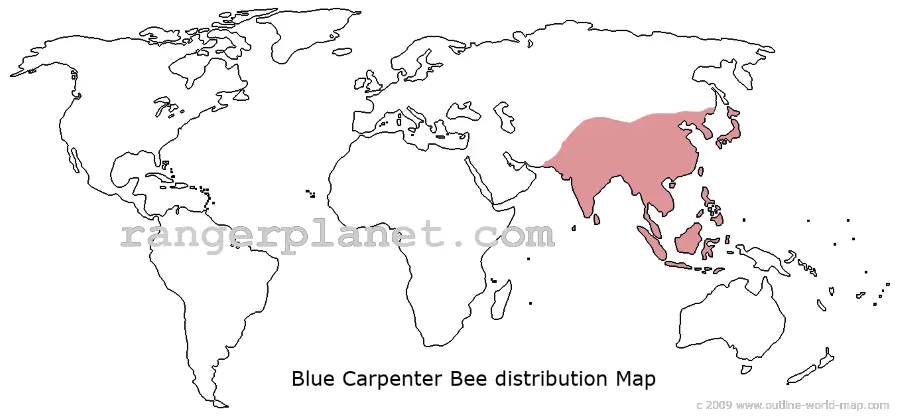
Blue bee classification
Xylocopa caerulea is part of a large insect group. The blue carpenter bee belongs to…
- Class: Insecta
- Family: Apidae
The scientific name of Blue Carpenter Bee is Xylocopa caerulea. Xylocopa the first name represents its genus and caerulea represents its species.
Blue carpenter bee anatomy
They can reach a normal size of 23 millimeters (0.91 in). These can resemble bumble bees but have more distinct body parts.
The back end of their body is clear, black and shiny, without any hairs. The thorax part of a blue bee is covered with dense almost glossy light blue hairs, giving it it’s striking blue shading. The sides of the belly and first stomach sections are additionally covered by hairs too, though a much finer and more slender layer of blue hairs.
They have larger mouthparts than most other bee species. Their beautiful wings are long and narrow in shape. Males are often different from females in color, they often have greenish-yellow fur on them – instead of blue.
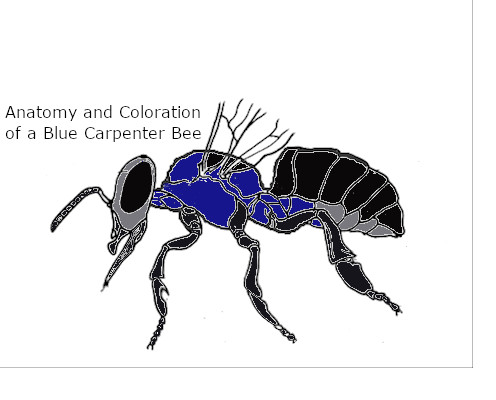
Habitat and Nesting
Blue Bees hibernate undercover through the winter and mate the accompanying spring. Once mating has taken place, the fertilized female blue carpenter bee will search for a suitable hole in any natural wood or will look to drill into the wood in order to make a passage to lay her eggs. The male bee plays no further part in the raising of the young bees.
The passageway openings in the wood surface are called ‘Galleries’ which are exactly round and about the measurement of your little finger. Digging Galleries is a laborious process that takes a great deal of time and vitality. Hence why the female will endeavor to look for existing homes as opposed to exhuming new ones.
Coarse sawdust might be available underneath the opening, and burrowing sounds are now and then heard inside the wood. The Blue Carpenter Bee does not build nests like other bees such as the honey bee. Instead, they may burrow so far into the wood, then turn to a right angle and continue boring a hole parallel to the surface of the wood.
Inside the Galleries, the Blue Carpenter bee will create about five to six individual cells that will be used to house their eggs. Working from the back of the chamber towards the front, the blue carpenter bee ‘fill’ each cell space with pollen, usually gathered from plants blossoming in spring, and deposit into each a solitary egg.
They will seal each egg chamber with a mix of saliva and wood sawdust and then begin the next one. In the late spring, the new blue bee hatchling will emerge as a larva.
Blue Carpenter bee life cycle
The life cycle of Xylocopa caerulea is similar to other species of Insecta class in Arthropoda phylum. Blue Carpenter bees have four life stages:
- Egg
- Larva
- Pupa
- Adult
It takes around seven weeks for a Xylocopa bee to reach full adulthood, however, formative time may fluctuate contingent upon calm or other natural conditions. Recently created grown-ups more often than not stay in their nest for a while and leave their brood cells around April or May as the temperature rises.
Blue carpenter bees have one offspring stage for every year in the northern states, however, in southern states like Florida, they may have at up to two egg-laying stages each year. Some times Xylocopa spp. shows the characteristic of Parthenogenicity, which means reproduction can occur without mating.
Here are some images of the Blue Carpenter Bee…
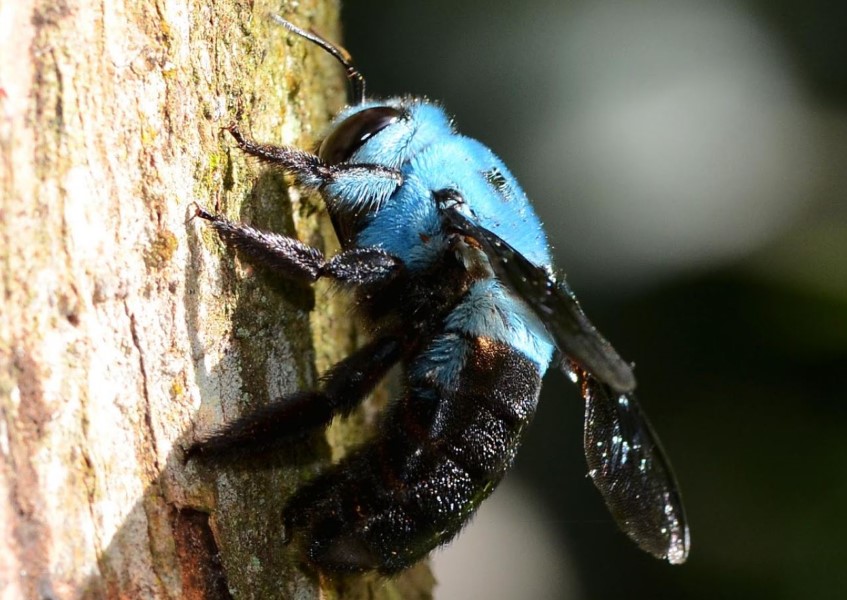
blue carpenter bee rear view 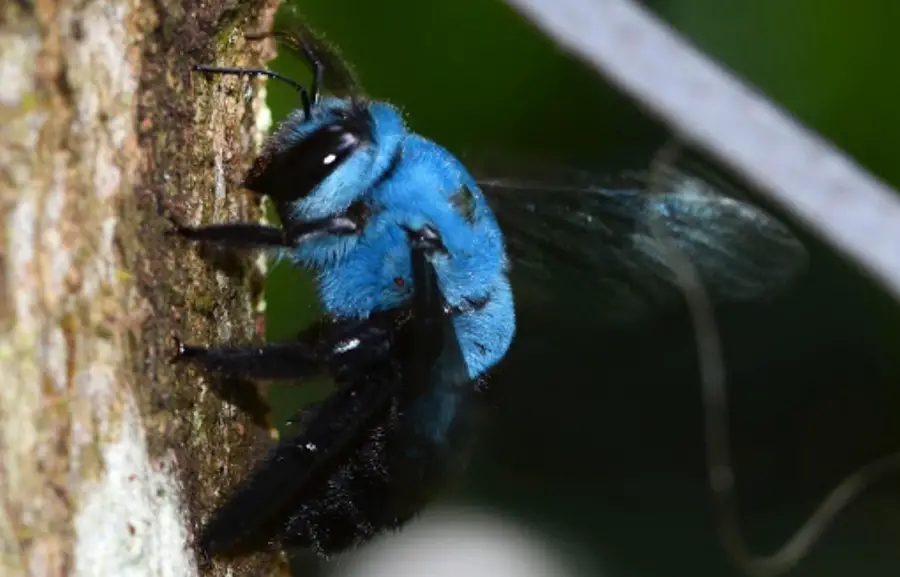
blue carpenter bee side view 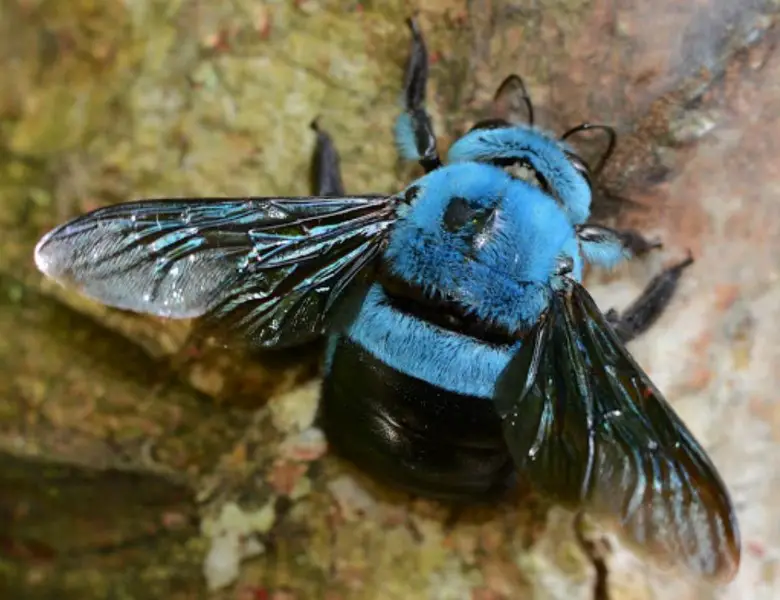
blue carpenter bee top view
Blue bee honey
Xylocopa bee makes honey thicker than a honey bees’ honey, they mix this with pollen to form a bee feed, over which they lay their eggs.
Blue bee feeding pattern
The Xylocopa caerulea doesn’t feed on wood, however. It feeds on pollen and nectar from flowers. They are also not carnivores. Blue Carpenter Bees are not considered to be aggressive either, the female has the ability to sting, however only occasionally does so when seriously threatened.
Environmental significance
Xylocopa caerulea, like most other bees, are significant pollinators and are valuable in providing pollination support of agribusiness, plant cultivators and natural product makers, and within the ecosystem as a whole. However, they are additionally an aggravation for homeowners as they can damage the wood.
Unpainted and seasoned wood is more prone to infestation of blue carpenter bee for causing damage. Male bees live for one year but a female can live for several years.
Control and Resources
There is often a need to control these arthropods which might be classed as a nuisance for wooden home materials and the wood industry.
Pest control
The prevention and control can be done with the help of Pest Management Professionals following a proper inspection. After the inspection has been made and its clear damage has been caused by the Blue Carpenter Bee, then using the relevant traps which is a known treatment for blue carpenter bee control and carpenter and mason bees in general. This highly rated Carpenter Bee Trap works well from Amazon.
Humane control
Although it’s easy for us to say, for the sake of the environment and our ecosystem, we really urge folks to opt for a more humane approach. So perhaps you could look at providing an easier solution by way of an alternative home for blue carpenter bees – including other Carpenter Bees, with this wonderful Carpenter Bee House! On amazon. With this, you can study them as they go about their business – great for teaching kids the importance of Bees in our environment.
So to finish…
We hope this has helped you understand more about the Blue Carpenter Bee, their habitat, behavior, mating and feeding and anything else we can share. We’d love to hear of your encounters with Blue Bees in general and for any images, you may have. So let us know in the comments below.
